
22 March 2021
Discover the charms of the ancient city of Kamakura at a serene hotel where Japanese tradition lives and breathes
The Hotel Metropolitan Kamakura opened its doors on April 24, 2020 in the popular tourist destination of Kamakura. We offer a staycation experience where guests can unwind and enjoy both sightseeing and hotel life, and so the debut of such a hotel has caused a great deal of excitement. Let us help you envision a trip to rediscover the charms of the ancient city of Kamakura through your stay at the Hotel Metropolitan Kamakura.
*Photos were taken in early December 2020. Our staff took thorough COVID-19 precautions and wore masks except in outdoor areas where they could avoid crowds.
Table of Contents
- 1Toshimaya Honten
- 2Kamakurabori Kaikan
- 3Kamakura Kimono Komachi
- 4Ebisuya - Kamakura Branch
- 5Kamakura Museum of Literature
- 6Hasedera Temple
- 7Yuigahama Beach
- 8Hotel Metropolitan Kamakura
- 9Tsurugaoka Hachimangu Shrine
- 10Kamakura Farmers Market
- 11Café&Meal MUJI
- 12Kenchoji
- 13Hachinoki Shinkan
- 14Houkokuji Temple
- 15Former Residence of Marquis Kachō
- 16Jōmyōji Temple
Toshimaya Honten
Don’t miss the cute retro dove goods that are only available here at the flagship location
Toshimaya’s Hato Sables are the quintessential Kamakura souvenir. These dove-shaped sable cookies were designed by the founder of the shop, which was established in 1894. We visited Toshimaya’s flagship location along Wakamiya Ōji Street because we heard that they sold seasonal sweets and original goods as well.
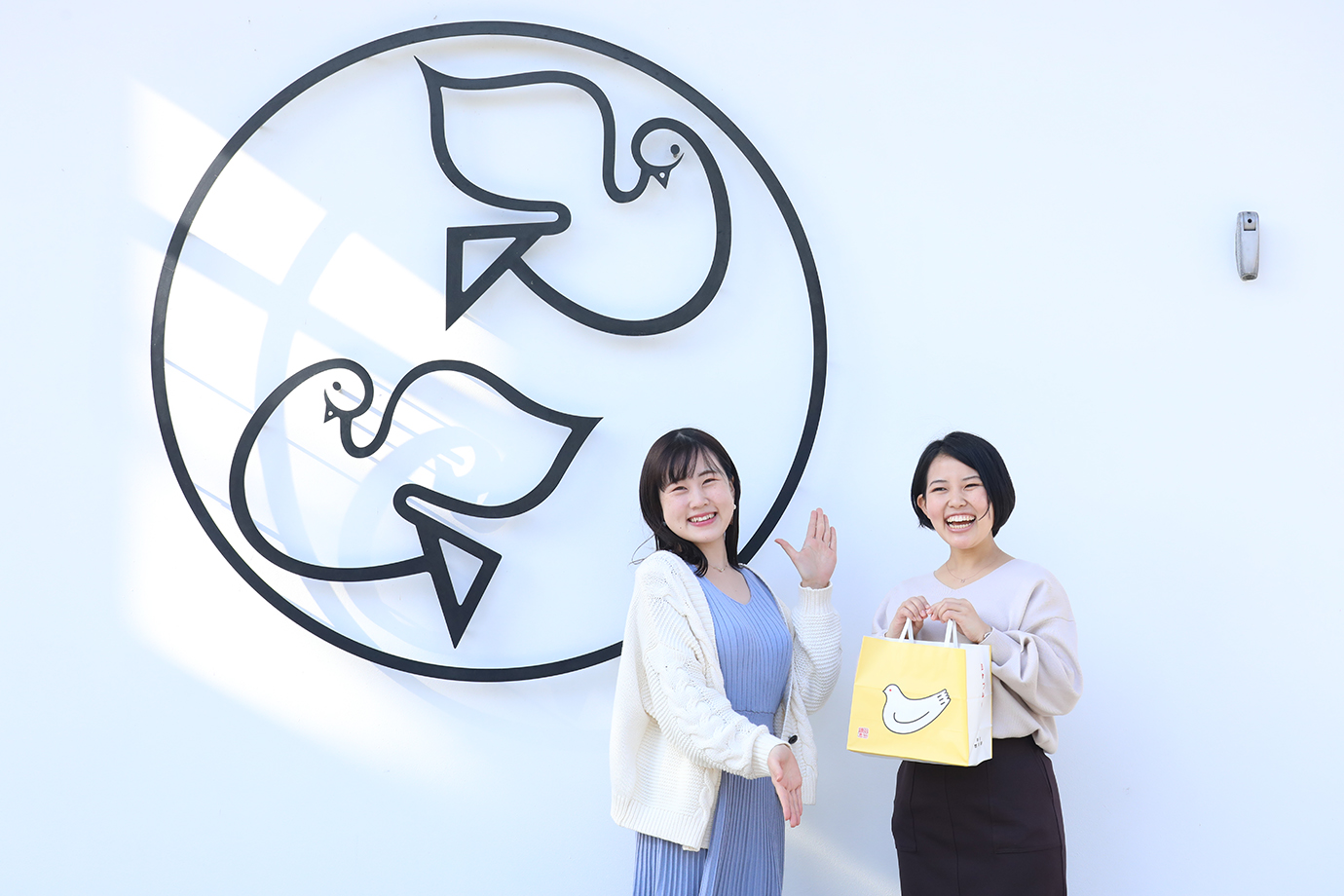
Holding the iconic yellow bag in a commemorative photo with the dove emblem on the wall outside
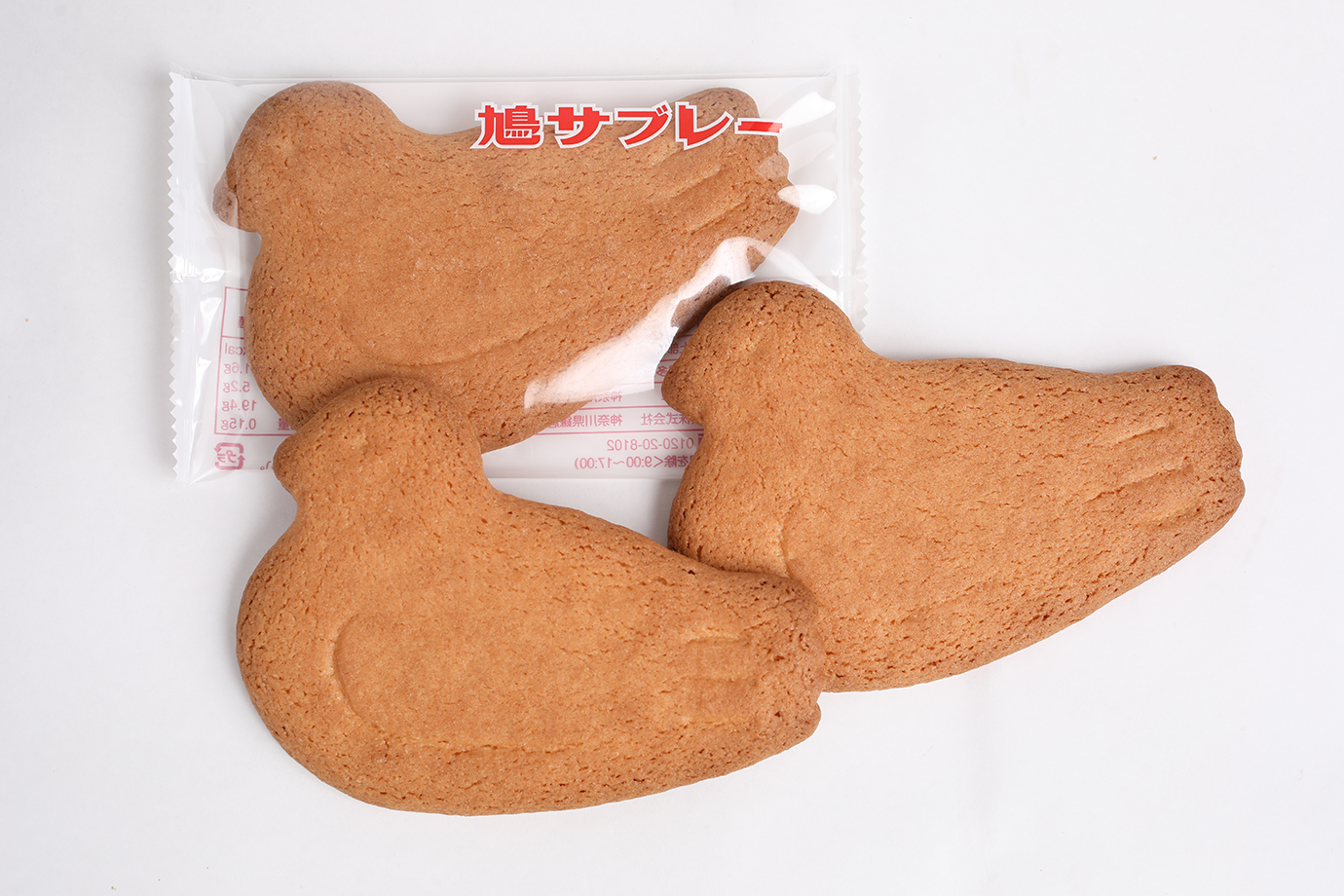
Hato Sables are sold on the first floor. They’re made with plenty of butter to achieve that irresistible crunch. The round dove shape is adorable too.

While a tin or box of sables also makes a good gift, we recommend the bag if you’re taking a stroll! The packaging is retro, and it comes with five Hato Sables.
A collection of cute dove items. It’s fun to imagine all the ways you can use it!

One corner of the shop is devoted to Toshimaya's original Hato Collection goods. In addition to pigeon motif goods with a retro design, you can also find stationery and notions featuring original characters like Hato Saburo and Hatobei. Toshimaya’s fourth CEO was involved in the planning of the Hato Collection, which has a lineup of more than 30 different items.

Their hatoson810 is “the only manual cleaner with unchanging dust collecting power”. You can’t help but laugh watching Hatobei’s busy little feet go pitter-patter as he cleans up eraser scraps.

Their Hatokeshi is such a realistic imitation of a Hato Sable that you’d never guess it was an eraser! Just try not to smile when you lift up the top and see a pair of red and white doves face to face ♪
Toshimaya Honten
Address:2-11-19 Komachi, Kamakura City
Phone:0467-25-0810
Hours:9:00–19:00
Regular holiday:Closed Wednesdays
Kamakurabori Kaikan
A café where you can experience the beauty of traditional crafts
Kamakurabori Kaikan is a gallery of the traditional craft of Kamakurabori lacquerware, but did you know about the chic Café Guri right behind the gallery? You can enjoy meals and coffee served in Kamakurabori lacquerware amid its elegant interior design. It’s the perfect spot for adults to enjoy lunch surrounded by handcrafted masterpieces.

Visit Café Guri and envision how Kamakurabori lacquerware could fit into your life. The café creates a luxurious experience by casually using an abundance of lacquerware pieces: trays, bowls, chopsticks, and more.
The Kamakurabori lacquerware brings out the beauty of the nutritious food

This is their shōjin (monastery-style vegetarian) meal (¥2000). The backbone of these dishes is the painstakingly prepared vegetarian stock, which brings out the sweetness and texture of the vegetables. You’ll love the melt-in-your-mouth frozen-dried tofu and Kamakura vegetables, ohitashi-style greens, and kenchin-jiru soup chock full of root vegetables.
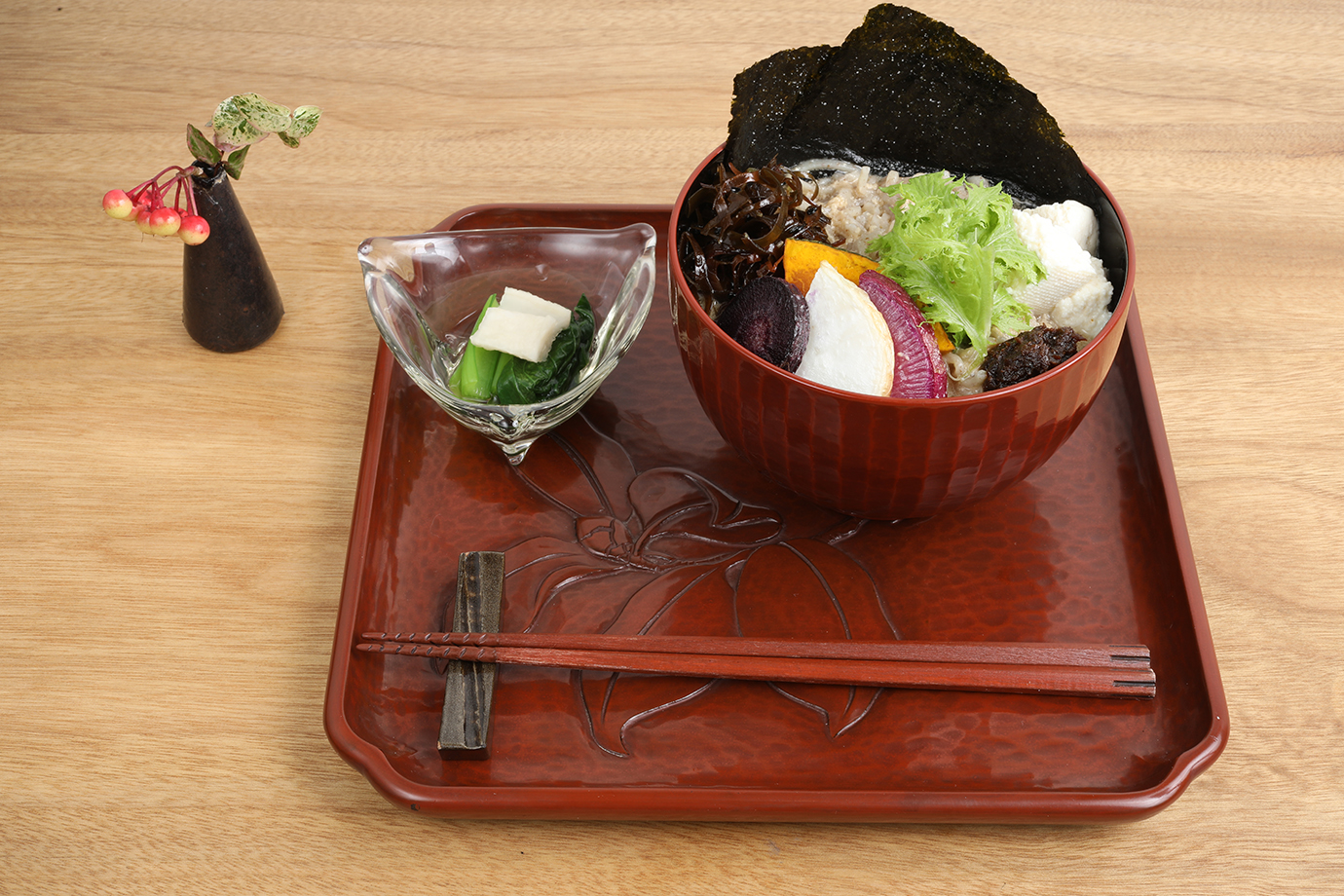
This is their Shōnan wheat gluten noodle bowl with sesame sauce (¥2000) Your body will thank you for this nutritious dish that’s rich in vitamins and minerals, with Shōnan-grown wheat gluten kneaded into the noodle dough. The colorful array of vegetables beautifully accents the vermilion-lacquered Kamakurabori bowl.

If you have a sweet tooth, we recommend the Guri Sweets set, which comes with their house-made pound cake, candied orange peel, and an array of other small sweets. Guri’s aromatic coffee pairs beautifully with their seasonal pound cake and house-made pudding.

The Kamakurabori Library on the third floor exhibits important lacquerware works from the Muromachi period (1338–1573) through present day. You’ll be surprised to see how the lustrous color and texture haven’t faded over the long years. (Admission to permanent exhibition: ¥300.)

Café & Shop Guri, Kamakurabori Kaikan
Address:2-15-13 Komachi, Kamakura City
Phone:0467-33-5751
Hours:11:30–15:30 (Shop hours 9:15–17:00, open daily)
Regular holiday:Closed Mondays (or Tuesdays if a national holiday falls on a Monday) (subject to other temporary closures, year-end and new-year’s holidays, and summer holidays)
*Hours and holidays may be subject to change depending on the COVID-19 pandemic situation. Check their official site or Facebook before visiting.
Kamakura Kimono Komachi
Stroll through the historic streets of Kamakura in elegant traditional Japanese dress
Kamakura Kimono Komachi, located near Kamakura Station, rents lovely kimonos for a reasonable rate. You can choose your favorite material, color, and pattern from the shop’s selection of more than 1,000 kimonos. Exploring the streets of Kamakura or Enoshima in our kimonos, we felt a bit like Kamakura experts.

The staff will advise you on how to choose the best kimono

Once you’ve finished at reception, pick out your kimono, zōri sandals, and accessories according to the plan you have selected. When we found too many things we liked and couldn’t choose, the staff gave us advice from a professional perspective. It’s fascinating how different materials and colors can be combined to create completely different impressions, from modern looks to retro ones.
-
The obi belts and obi-jime cords are displayed beautifully, just like works of art.
They’ve set it up so it’s easy to create different combinations and imagine wearing them. The bold designs of these obi belts will suit a modern kimono. 

-
It will take about 30 minutes to get you dressed. They’ll also do your hair and makeup after. The staff handled everything attentively and transformed us totally different people. Wrapped up in these glamorous kimono, we started to feel excited.
If you want to wear your kimono to a temple or shrine, you’ll need to return it by closing time (around 17:30). Another thing we liked is that they offer a variety of kimono rental plans to suit different itineraries, like a couple’s plan for a date in Kamakura or a yukata plan for summer fireworks.

The original heart-shaped ema plaques are also very cute.

Kamakura Kimono Komachi
Address:1-6-4 Yukinoshita, Kamakura City
Phone:0467-405-769
Hours:9:00–18:00
Regular holiday:Open daily
Ebisuya - Kamakura Branch
A carefree rickshaw ride around the ancient city
We decided to tour Kamakura in a rickshaw. Ebisuya offers three different excursion courses, including one starting from the Ninotorī gate. It felt like such a special experience to ride around Kamakura with the rickshaw drivers who know its every little detail, including small rear temples, Tsurugaoka Hachimangu Shrine, and the sights of the city. Once you choose your preferred course, your rickshaw trip can begin.

The driver was touchingly attentive and knowledgeable.

While tours usually start from the Kamakura Station area or the Ninotorī gate, this time they picked us up at the hotel entrance. We thought it might be difficult to climb into the high seats in our kimono, but the driver supported us effortlessly.

The driver made interesting conversation along the way, and the time just flew by as he told us where to take commemorative photos and all about the temples and shrines. Depending on the course you choose, they can also show you around inside temples and shrines.

The rickshaw’s swaying is gentle as you move faster than walking though slower than biking.
Ebisuya - Kamakura Branch
Address:1-12-3 Yukinoshita, Kamakura City
Phone:0467-61-3344
Price:1 passenger from ¥3000, 2 passengers from ¥4000
Hours:9:30 to sunset (varies by season)
Regular holiday:Open daily
Kamakura Museum of Literature
Discover the literature of Kamakura in a mansion with a beautiful rose garden
Pass through the vivid green arch and antiquated tunnel, and there in front of the gardens stands the Kamakura Museum of Literature. The museum is located in the villa of the former Marquis Maeda family, which is a registered tangible cultural property of Japan. In the art deco interior, they exhibit the works and materials of Kawabata Yasunari, Natsume Sōseki, and various other literary figures under the theme of literature with ties to Kamakura.

A shot in the garden in front of the museum. The kimonos and the Western architecture make a striking combination.
The roses in full bloom in front of the Shōnan sea... It’s just like a painting.
The museum’s gardens have a wide rolling lawn and azalea hedges as well as a rose garden in the back. There are 250 rose bushes of about 200 varieties, including roses with locally-inspired names, like “Kamakura” and “The Dance of Shizuka.”
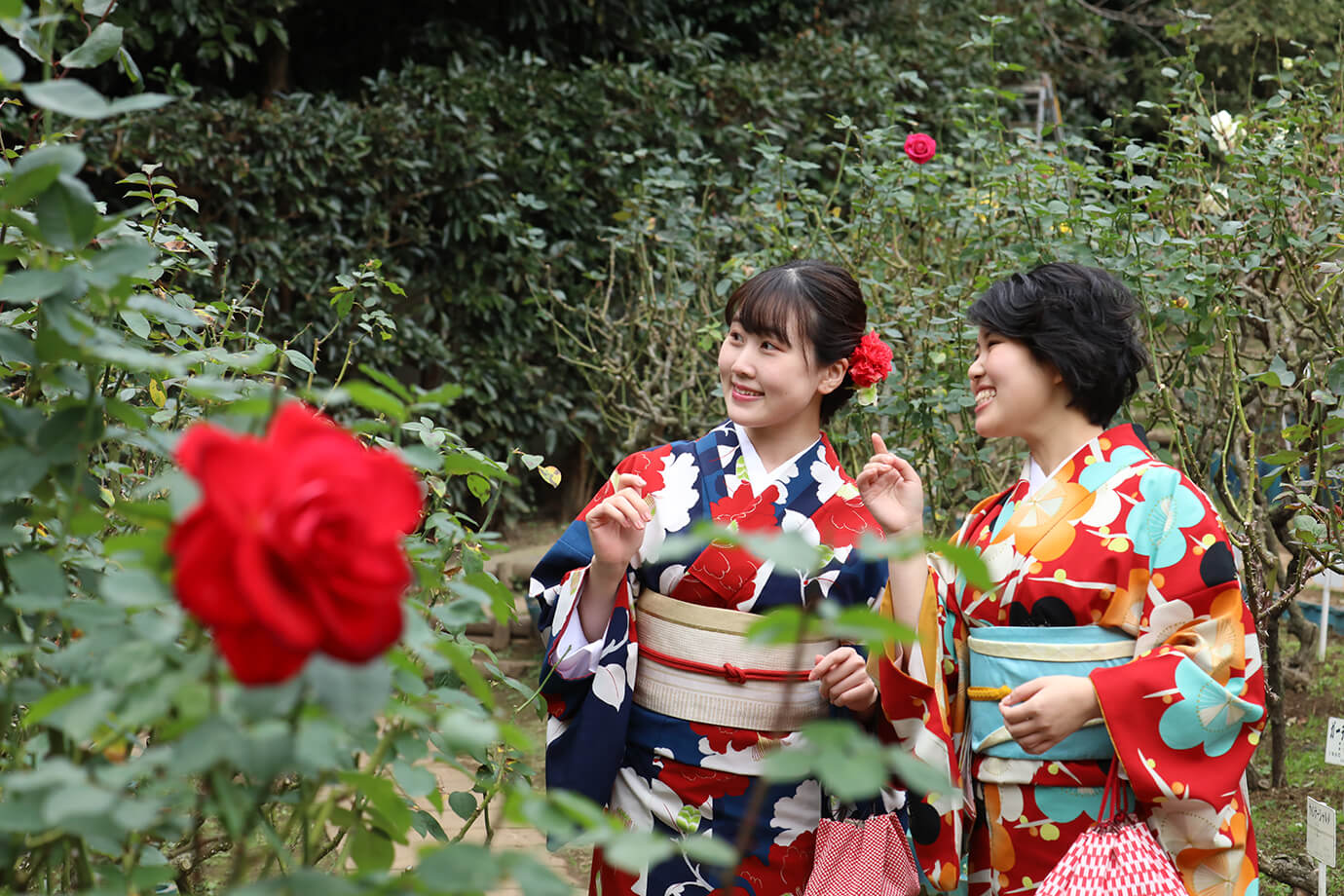
The rose garden was not in full bloom when we visited, but there were some gorgeous blossoms remaining. On a clear day, you can see beyond the gardens to the sea.

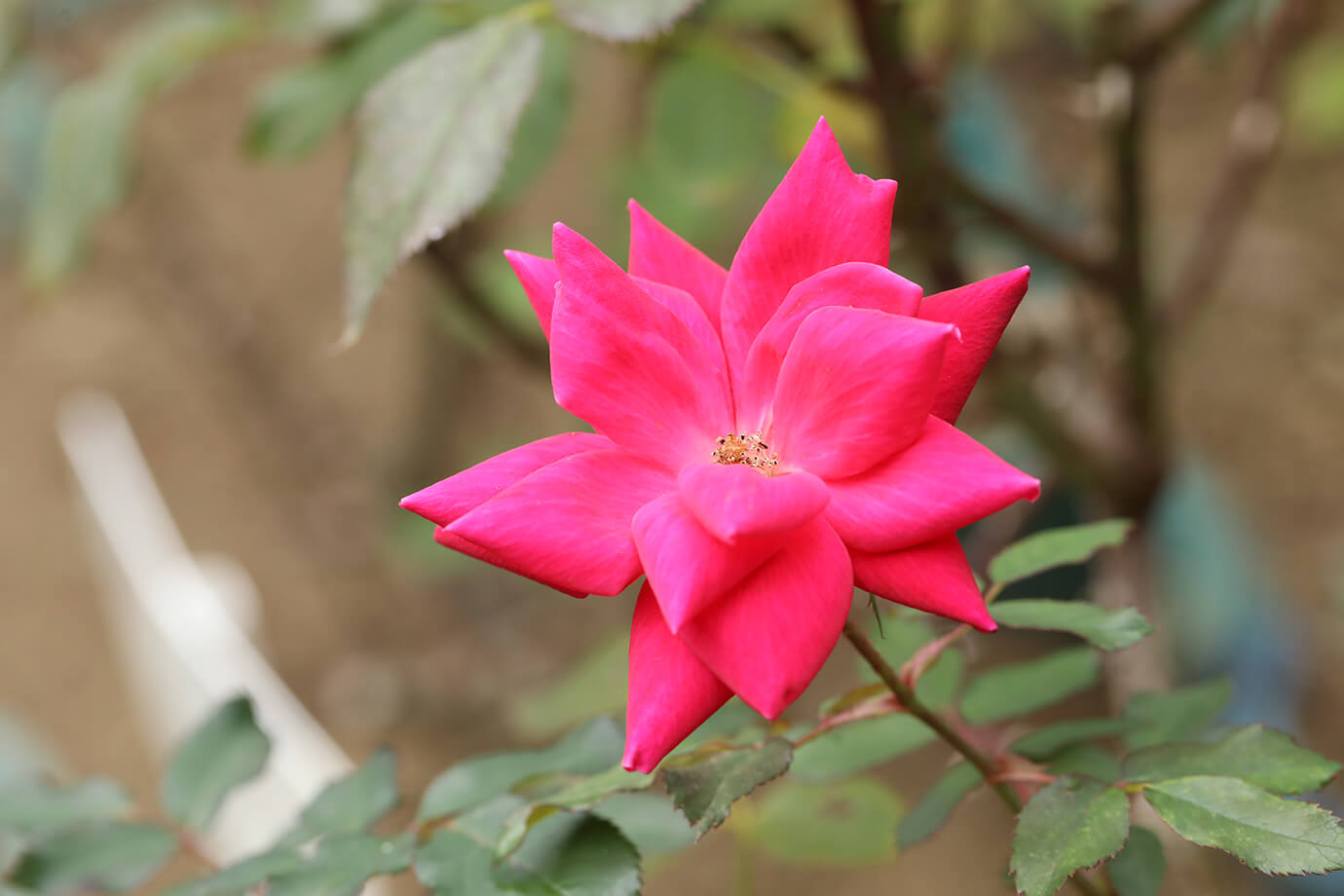
The red and yellow roses look beautiful. It’s best to visit from mid-May to mid-June for spring roses and from mid-October to mid-November for autumn roses.
See important artifacts in a classic Art Deco space

We took off our zōri sandals at the entrance of the museum and went inside to see manuscripts and books by famous Japanese artists and other valuable materials in a classic space with a sense of history.

The stained glass that washes the permanent exhibition room with gentle light features painstaking and beautiful workmanship. The shop also sells goods with a retro design, like bookmarks with a stained glass motif.
Kamakura Museum of Literature
Address:1-5-3 Hase, Kamakura City
Phone:0467-23-3911
Price:Admission ¥300–¥500
Hours:9:00–17:00 (closes at 16:30 from Oct. to Feb.)
Regular holiday:Closed Mondays (except on national holidays / in May, June, and November)and during exhibit changes
Hasedera Temple
A temple with flowers and magnificent views of a wooden Kannon statue
Founded in 736, this ancient temple has been known as Hase-Kannon since time immemorial. The Kannon-do Hall on the hill enshrines the 11-faced Kannon bodhisattva statue, one of the largest wooden statues in Japan. Explore the lush green grounds to visit sites like Benten-kutsu Cave, Kyozo (the scripture repository), and Amida Nyorai Hall while enjoying the seasonal flowers and plants.

We got unexpectedly fired up posing at the big lantern at the temple gate!
All around the grounds you are greeted by seasonal flowers.

Hasedera Temple is known as a temple where you can enjoy flowers throughout the four seasons. As the seasons change, Japanese water irises and magnolias bloom in the walkabout garden, and hydrangeas and peonies greet visitors along the temple path.

-
In January, ginkgoes and Japanese maples transform the scenery into something like a nishiki-e woodblock print. It’s also the only spot in Kamakura that’s illuminated at night during the foliage season.
Taking a moment to gaze at the ocean from the lookout platform

Make your way to the back of the grounds and you will find a lookout platform, a scenic spot overlooking the Shōnan sea and the city of Kamakura. As you gaze out over the glittering coastline, you’ll forget any fatigue from your walk. There are chairs and tables where you can take a break while enjoying the sea breeze.
It’s hard to know what’s better, the view or the sweets!

Kaikoan, a restaurant near the lookout platform, sells sweet non-alcoholic sake (available in winter only) and the temple’s famous lucky dango. We also recommend their meals, which include vegan options inspired by shōjin (monastery-style vegetarian) cuisine. Try their modern and appealing Temple Curry or Vegetable Pasta. Of course you can also enjoy a panoramic view of Yuigahama Beach from the restaurant.

Strolling in the bamboo forest is very pleasant.
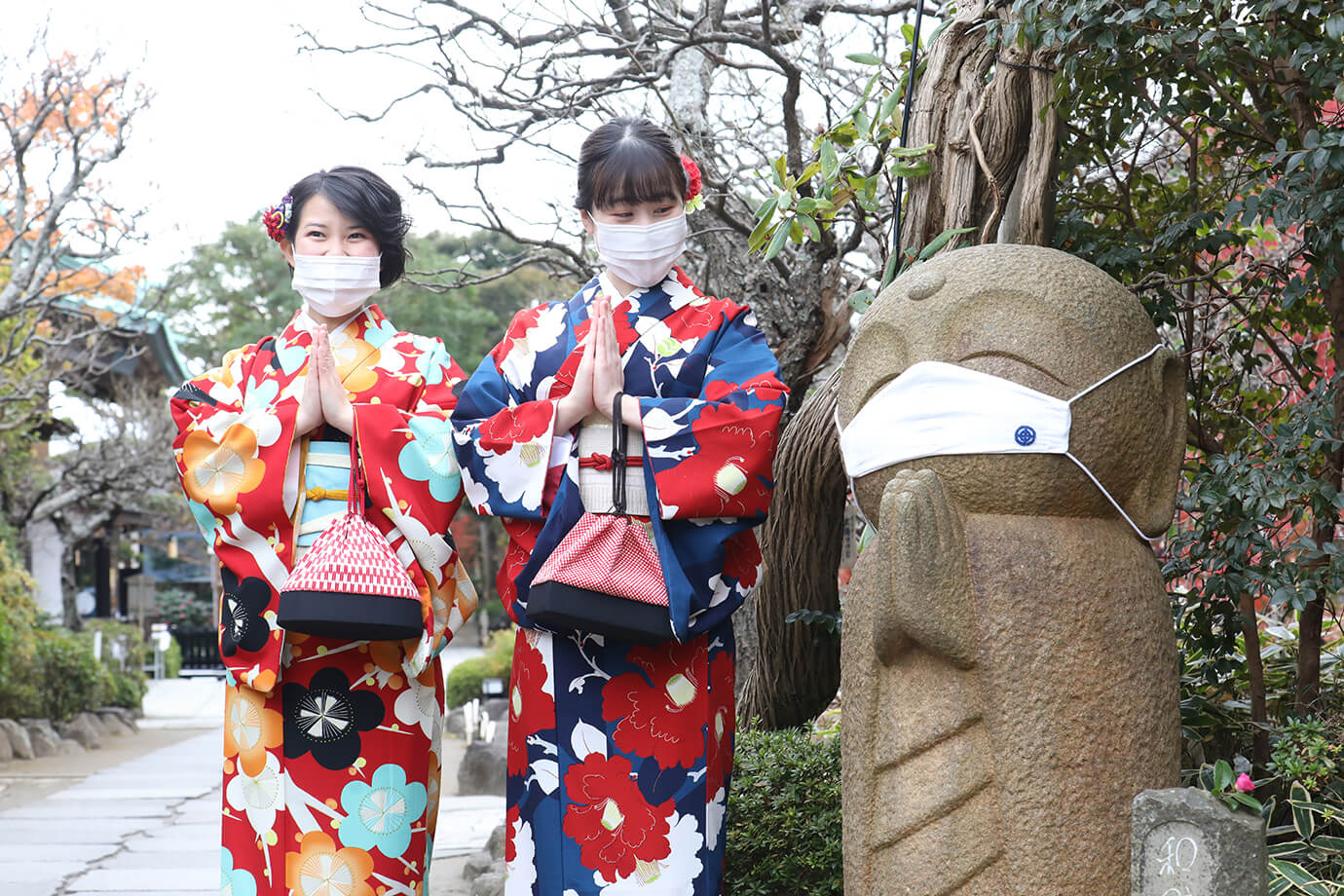
The Nagomi Jizo statue is enshrined along the temple path. It looks so cute with its mask ♪ You should also search for the three Ryoen Jizo statues, who are said to help foster good relationships.
Hasedera Temple
Address:3-11-2 Hase, Kamakura City
Phone:0467-22-6300
Price:Admission ¥400
Hours:8:00–17:00 (closes at 16:30 from Oct. to Feb.)
Regular holiday:Open every day
Yuigahama Beach
Now to the lookout spot where the scenery changes moment by moment with the setting sun
Yuigahama Beach is famous as a place to swim in Kamakura, and it’s also known for its beautiful sunset. Take the Enoden railway from Kamakura Station and get off at Hase Station or Yuigahama Station, and then it’s about five minutes on foot. The shoal gets a steady ocean breeze, so you can watch surfers riding the waves. We visited in the evening, so it was perfect time to watch the sunset over Inamuragasaki. It was gorgeous to see the sky dyed orange over the surface of the water.

The sun sets slowly and beautifully. This is the best Instagram spot!
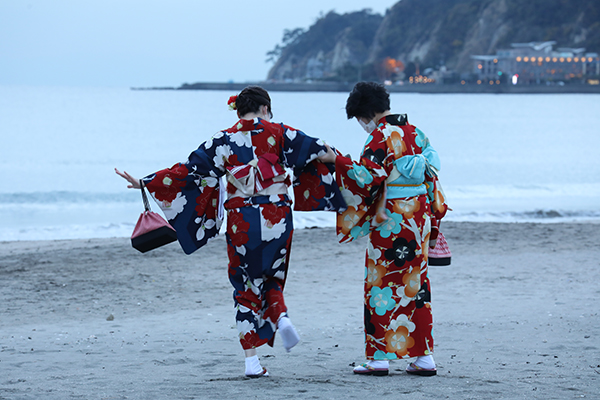
After seeing temples and shrines in our kimono, it was also nice to stretch our legs with a walk to Yuigahama Beach.

The kimono will look so beautiful in your photos. Let the sound of the waves soothe you while taking a leisurely stroll ♪
After a walk along the beach, our day's journey is over. Now it’s time to make our way slowly back to Kamakura to return the kimonos.
Yuigahama Beach
Address:Yuigahama, Kamakura City
Phone:0467-61-3884 (Kamakura City Tourism Office)
Hours:Open all day
Hotel Metropolitan Kamakura
A healing space in harmony with nature, unique to Kamakura
The hotel was established in April 2020 along Kamakura’s main road, Wakamiya Ōji Street. As a new landmark of the neighborhood around Kamakura Station, it attracts locals and tourists alike.

Natural stones and green trees are arranged in the courtyard, enveloping the space with a sense of natural harmony. The soothing feeling of the expansive yet comfortable space extends even to the rooms.

The courtyard is full of plants and paved with ōya stone, and at night, it’s illuminated for a new and different atmosphere. You can also take the stairs up to the second-floor reception area.

In the courtyard, keep your eye out for a well-shaped flower bed made of rare Kamakura stone.
Relax in an extraordinary space with a terrace and a Japanese-style veranda
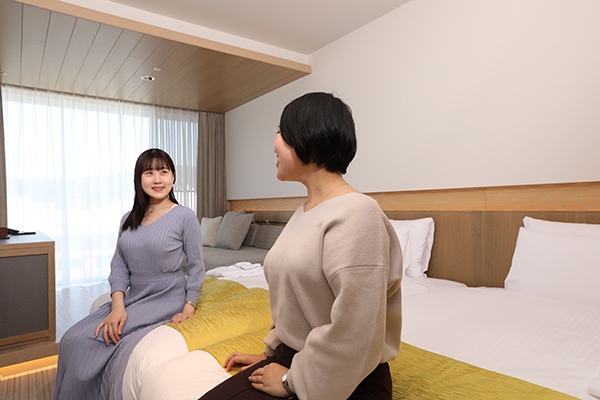
The hotel offers 12 different types of rooms, including the Garden Room, which has large windows and an outdoor terrace, and the Superior Room, which has a raised floor area inspired by a Japanese-style veranda.

Each room has a bathroom with a bathing area, and there are many amenities that women will appreciate, like foot care sheets, steam eye masks, and a basic cosmetics set.

The Premium Corner Room is a corner room with two enormous windows. It’s a bit of a luxurious room, with the Ninotorī gate of Tsurugaoka Hachimangu Shrine visible outside the window. You can enjoy the typical views of Kamakura to your heart’s content while relaxing in your room
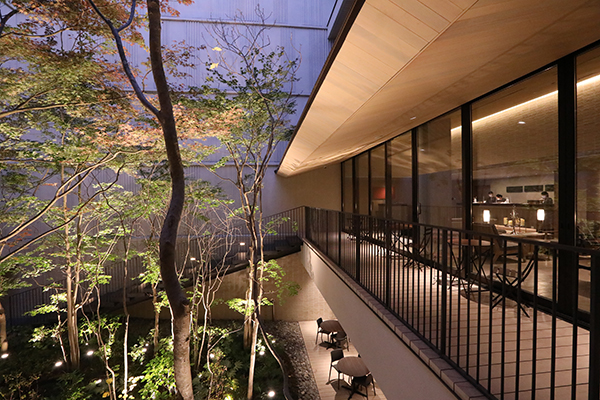
The design of the terrace outside the lobby was inspired by the essence of a Japanese-style veranda. The illuminated trees are a wonderful sight at night.

Having a leisurely chat on the terrace overlooking the courtyard ♪ Maybe we should plan for tomorrow, huh?

With its spacious interior with sofas and tables made of natural materials, the lobby is a comfortable and relaxing space to unwind. It also has a table with a power outlet for charging your smartphone or doing a little telework on your computer.
We’re not ready for the fun to stop; there’s so much to do in Kamakura!
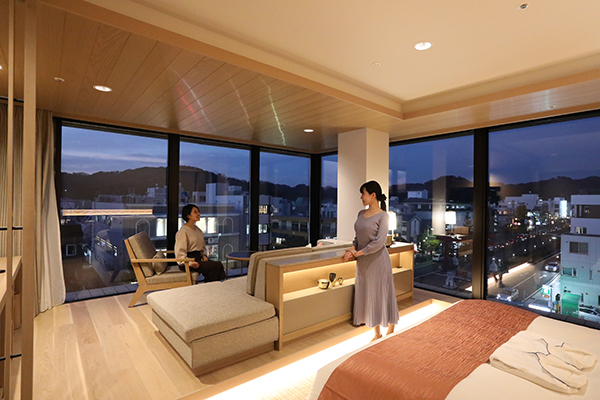
But we’re staying the night so we can keep going until late. We have lots of time and don’t need to worry about the last train. It’s so nice to enjoy all kinds of things: shopping, Kamakura’s gourmet scene, and chilling out in the room. There are so many fun things we want to do. The silhouettes of the mountains of Kamakura and the city lights look lovely from the window.

It’s also lovely to spend time relaxing in the room while enjoying the night view.
Hotel Metropolitan Kamakura
Address:1-8-1 Komachi, Kamakura City
Phone:0467-60-1111
Check in:15:00:
Check out:11:00:
Rates:From ¥17,400
Tsurugaoka Hachimangu Shrine
An early morning visit to the shrine where Kamakura culture originated
Tsurugaoka Hachimangu Shrine was built by Minamoto no Yoritomo to house the guardian deity of the Minamoto clan and to serve as the center of Kamakura's urban development. We recommend visiting in the early morning, before the city comes to life. Praying in the quiet is such a dignified feeling. The Ninotorī gate in front of the Hotel Metropolitan Kamakura, leading to the raised shrine path, which was built to pray for the safe childbirth of Hōjō Masako, the wife of Minamoto no Yoritomo. We walked along this path to visit Tsurugaoka Hachimangu Shrine.
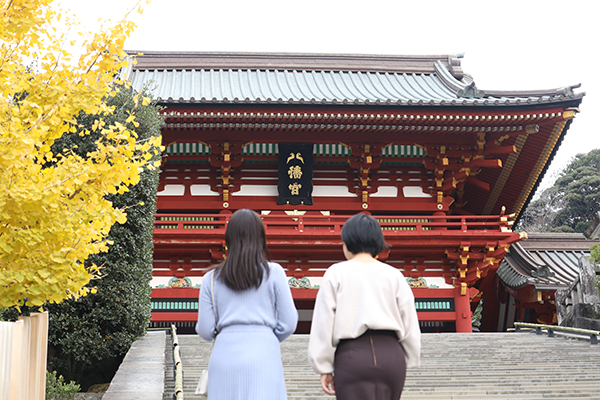
An early morning visit can energize you physically and mentally for the day ahead.
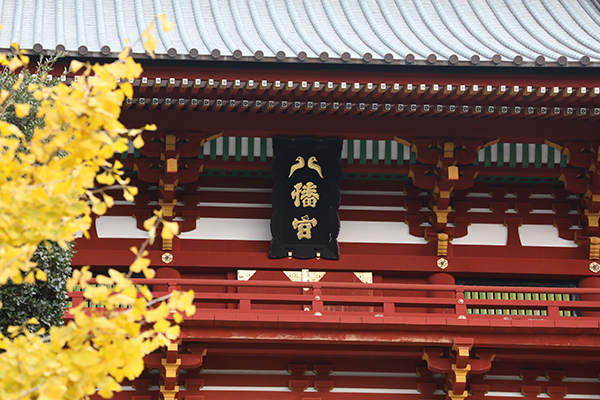
Look closely at the frame at the center of the two-story gate, and you can see two doves forming the character 八 (the “hachi” of Hachimangu). Doves are said to be the messengers of the deity Hachiman.

The temple grounds are usually very busy, but in the early morning, you can move at a leisurely pace. Focus on your heart’s desire as you clasp your hands in prayer.
Most people’s first association with a Hachimangu shrine is vermillion-lacquered buildings.
In addition to the Main Shrine and Wakamiya, which are nationally designated important cultural properties, the large grounds are also home to the Kamakura Kokuhoukan Museum and the Tsurugaoka Museum, Kamakura. The current Main Shrine building was constructed by Tokugawa Ienari, so it has a shōgun-period feel. The Maiden, also known as Shimo Haiden, stands in the ruins of the Wakamiya cloister, where Shizuka Gozen once danced for Yoshitsune to express her adoration.

-
This is the best lookout spot to see the Maiden and the Main Shrine from the temple approach.

On either side of Taikobashi Bridge, which crosses the temple approach, you can see the red and white lotus flowers that bloom in summer. They are a hallmark of the season in Kamakura. The Masako Stone enshrined in Hataage Benzaiten Shrine in Genji Pond is said to bless visitors with a happy marriage and easy childbirth.
Tsurugaoka Hachimangu Shrine
Address:2-1-31 Yukinoshita, Kamakura City
Phone:0467-22-0315
Price:Free admission
Hours:5:00–20:30 (from 6:00 from Oct. to Mar.) *Currently open until 20:00
Regular holiday:Open every day
Kamakura Farmers Market
For fresh Kamakura vegetables, visit Renbai, where the pros go
We visited a farm stand where farmers from Kamakura and the town of Nagaodai in Yokohama City sell their produce. Locals call this beloved institution “Renbai.” We visited at 8:00 in the morning, with the chefs and other food professionals, and saw rows of vegetables brought in by farmers.
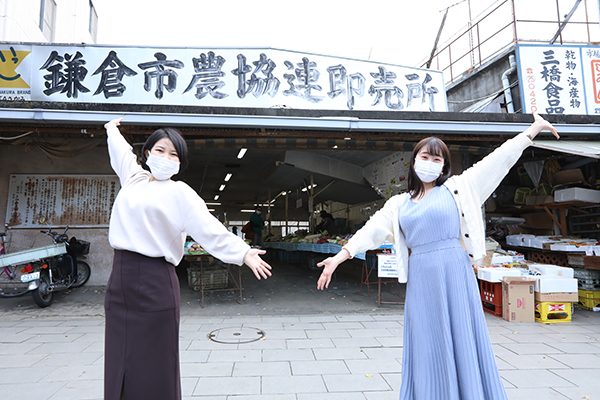
It may seem a bit intimidating, but it’s actually a comfortable place even for ordinary people to sh
The vegetables grown in the open air are rich and delicious in flavor and aroma

The 22 farmers here are divided into four groups that take turns manning the stalls so there are different types of vegetables on offer each day, including rare ones that you can't find in supermarkets. They sell standard Japanese vegetables as well as Western vegetables and herbs, so it feels like a European open-air market. We understood why chefs from famous restaurants would visit from far away.

If you have any questions about how to prepare the vegetables or when they are in season, just go ahead and ask.

There were lots of vegetables that were new to us, like Swiss chard and baby mustard greens. Ask the farmers directly “How should I prepare this?” and get inspired to try making something new.

-
You can buy local Kamakura vegetables in the morning, drop them off at the hotel, and then go out sightseeing. We should do all our trips like this from now on. Now we can look forward to enjoying the fresh and bold flavors of Kamakura vegetables at home.
Kamakura Farmers Market
Address:1-13-10 Komachi, Kamakura City
Phone:Unlisted
Regular holiday:Closed Jan. 1–4
Café&Meal MUJI
Linger happily over a breakfast that highlights the flavor of the ingredients
After a busy morning at the shrine and the farm stand, we sat down for breakfast at Café&Meal MUJI, the restaurant annexed to the hotel. From 6:30 to 10:30, it’s open exclusively for hotel guests to enjoy a leisurely breakfast. In the warm, comfortable, wood-adorned café, you’ll get energy for the day ahead with a breakfast that’s full of local ingredients.

Enjoy breakfast time in a nature-inspired space surrounded by a natural wood grain interior. During these luxurious hours, guests have the run of the spacious restaurant.
They offer both Japanese and Western breakfast options. The Japanese breakfast uses a Kamakura specialty, whitebait, in the Pork Soup and Whitebait Set. The Western breakfast is a Pork Keema Curry Toasted Sandwich. Both use plenty of local ingredients, like Kamakura seaweed-fed pork and Kamakura vegetables from Renbai. You can help yourself to yogurt, granola, bread and drinks at the buffet corner.
Always full of life, a new style restaurant that fits the community
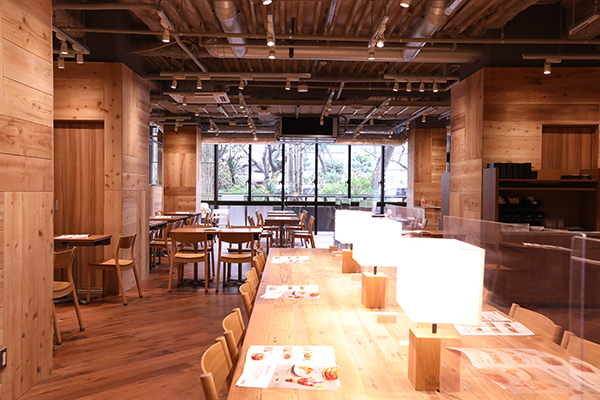
Café&Meal MUJI is also popular with local regulars. After 11:00, it opens for customers other than hotel guests to use as they like. If there’s anything you need during your stay, the attached MUJI com store sells clothes, notions, and food products. It also has an open space that can be used for various purposes, and it serves as a community space for locals and tourists.
Café&Meal MUJI
Address:Hotel Metropolitan Kamakura 1F, 1-8-1 Komachi, Kamakura City
Phone:0467-22-7852
Price:Breakfast ¥2,000
Hours:Breakfast menu 6:30–10:30, Grand menu 11:00–22:00
Regular holiday:Open daily
*Hours and availability are subject to change depending on the COVID-19 pandemic situation.
Kenchoji
Feel the power of tengu at the ancient temple of the Kamakura Gozan
The ancient temple of Kenchoji was built by Hōjō Tokiyori in 1253. It is the first among the Five Great Zen Temples of Kamakura, and it was designed in the Zen style using a garan layout, where the Main Gate, Triple Gate, Main Hall, and other major buildings are arranged in a straight line. If you walk to the Hansobo shrine in the innermost part of the grounds, you can feel the power of tengu, a supernatural being.

The triple gate is an important cultural property of Japan that conveys grace and history. It makes a truly stunning impression.

They say that passing through the triple gate signifies being freed from all attachments.

The Main Hall enshrines a seated statue of the Jizō bodhisattva, the principal object of worship of Kenchoji. It is said to be imbued with the desire of Hōjō Tokiyori and Lanxi Daolong to be saved from delusion and attain enlightenment.
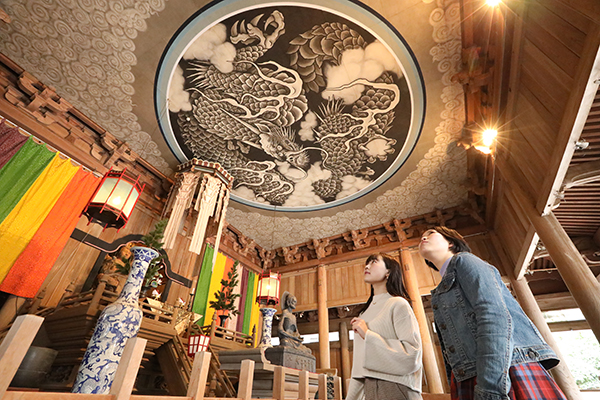
On the ceiling of the largest temple hall in Kantō, you can see a ceiling painting of the cloud dragon Unryū that looks ready to start moving any moment. It was painted by Junsaku Koizumi to commemorate the 750-year anniversary of the temple's founding.

-
The beautifully contrasting black and gold decorations of the karamon gate are works of art.
As you take in the foliage, climb the steps to the Hansobo shrine where the tengu statues await.
At the top of the 249 steps is the Hansobo shrine at the innermost part of Kenchoji Temple. We visited just during the foliage season, so we gazed out over the changing colors of the treetops as we ascended. Hansobo shrine is a scenic spot where you can see Yuigahama seashore and even Mt. Fuji if the weather is clear.

The steps leading to the semi-monastery are also famous as a foliage spot. We ascended slowly, taking pictures of the beautiful foliage leaves on the way up.

There, surrounded by many statues of tengu, you can really feel their power.
Kenchoji
Address:8 Yamanouchi, Kamakura City
Admission:¥500 for adults, ¥200 for elementary and middle school students
Hours:8:30–16:30
Regular holiday:Open every day
Hachinoki Shinkan
Today, we’ll have lunch at a famous Japanese restaurant that serves kaiseki cuisine.
Visit Hachinoki Shinkan, established in 1964, to enjoy a lunch of shōjin and kaiseki ryōri (respectively, monastery-style vegetarian cuisine and multi-course haute cuisine). While kaiseki might sound a little exclusive, at lunchtime, you don’t even need a reservation. Take the opportunity to leisurely enjoy the flavors of a famous restaurant at a table overlooking a beautiful Japanese garden.
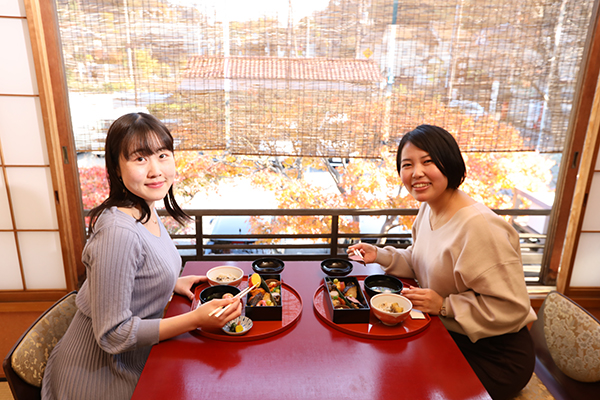
Gaze at the Japanese garden as you walk along the path and enter the restaurant. There are table seats on the first floor and Japanese tatami rooms on the second floor. With seasonal ingredients procured from all over the country, you can really feel the seasonality of the menu.
Everything is colorful and beautiful and delicious!

The grilled fish meal (¥2750) is extravagant, delicious, and a feast for the eyes. It comes with seasonal fish grilled yuan style, seasonal ohitashi-style greens, and rice cooked with mushrooms.

One step up is the kaiseki meal (¥4180), which comes with roast wagyū beef, Spanish mackerel grilled saikyō style, and rice topped with abalone.

Each dish is carefully prepared, and every bite is a delight.
It was wonderful to experience how delicious kaiseki cuisine is over lunch.
Hachinoki Shinkan
Address:350 Yamanouchi, Kamakura City
Phone:0467-23-3723
Hours:11:30–14:30, 17:00–19:00 (weekends: 11:00–15:00, 17:00–19:00) *For dinner, reservations must be made by the previous day.
Regular holiday:Closing schedule varies
Houkokuji Temple
An bamboo garden at an ancient temple where you can lose yourself in a watercolor world
The historic Houkokuji Temple, known for its beautiful bamboo garden, dates back to the year 1334. In the bamboo garden behind the Main Hall, about 2000 mōsō bamboo plants stretch high into the sky, creating a beautiful contrast between the streaming sunlight and the bamboo. The world spread out before us like an ink-wash painting, and we could feel a sense of calmness settling gradually over us.

-
The silence created by the mōsō bamboo forest can calm both your mind and body.
Let the mysterious power surround you.
There is a promenade in the bamboo garden, and the path is flanked by Jizō statues and moss-covered lanterns. In one corner of the bamboo garden is a teahouse that serves matcha (¥600; comes with dry confectionery).

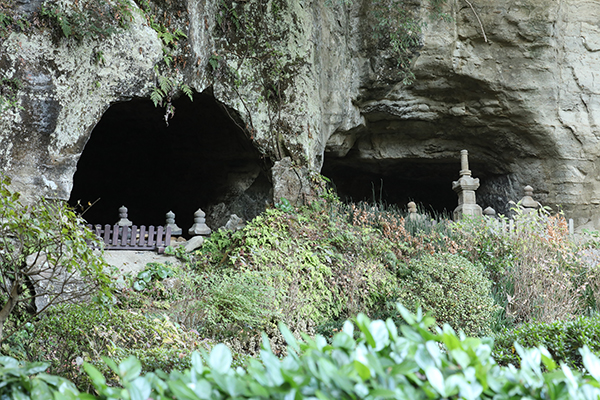
Hokokuji Temple is also known as the site of the demise of the Ashikaga clan. At the back of the bamboo garden, a horizontal tomb is carved into the rock face. This is the final resting place of Ashikaga Ietoki and Yoshihisa.

The dry landscape garden in the courtyard is also quite a sight. Natural stones and plants are arranged against the mountain in the background.

The ripples of the dry landscape rock garden are beautiful too. They look just like ripples on the surface of water.
Houkokuji Temple
Address:2-7-4 Jōmyōji, Kamakura City
Tel.:0467-22-0762
Price:Admission ¥300
Hours:9:00–16:00
Regular holiday:Closed Dec. 29–Jan. 3
Former Residence of Marquis Kachō
An early Shōwa-era Western-style building and a former aristocratic residence
A short distance behind Houkokuji Temple, you will see a striking building with Western architecture. It was built in 1929 as the residence of Marquis Kachō Hironobu, a former aristocrat, and it is known as one of the Three Western-style Houses of Kamakura. The building is a registered tangible cultural property of Japan, and is used as a filming location for dramas along with the French-style gardens.
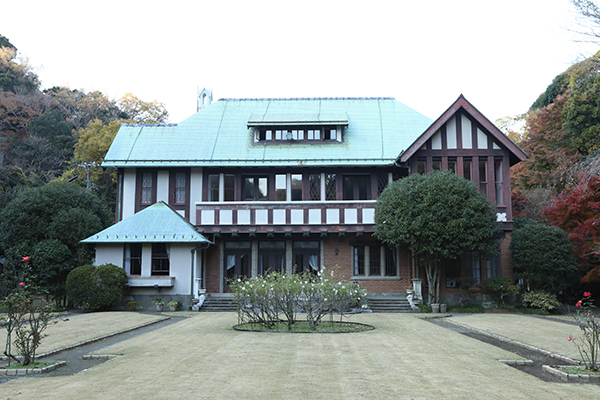
Normally, visitors are not allowed inside the building, but it opens to the public about twice a year (canceled as of 2020). On these days, you can see the interior and the tea room, Muian (only the exterior is open to the public). The French-style garden is open to the public (except on Mondays and Tuesdays) and you can explore it freely.
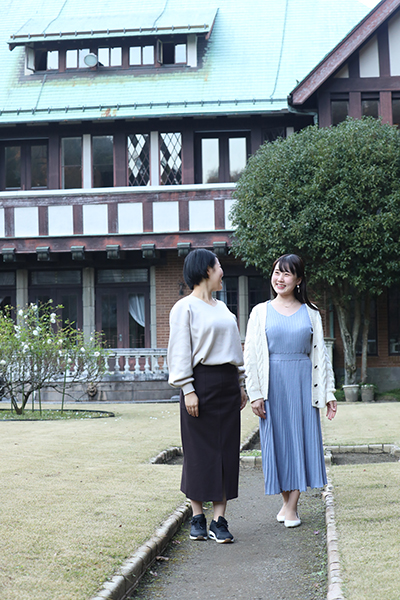
-
Challenge yourself to get some photogenic shots with the beautiful garden and the Western-style building in the background
-
The gardens have many different faces throughout the four seasons. There are roses in spring and autumn and hydrangeas in early summer, but the beautiful autumn foliage makes an unexpectedly fascinating contrast with the Western architecture.

Former Residence of Marquis Kachō
Address:2-6-37 Jōmyōji, Kamakura City
Tel.:0467-61-3477 (Kamakura City Scenery Office)
Price:Free
Hours:10:00–16:00 (closes at 15:00 from Oct. to Mar.; the building is open about twice a year)
Regular holiday:Closed Mondays, Tuesdays (or the following workday if a national holiday falls on either day), and year-end and New Year holidays
Jōmyōji Temple
A luxurious experience with matcha in a Zen temple teahouse
We got to experience drinking matcha in this historic temple built by Ashikaga Yoshikane in 1188. Kisen-an is a teahouse on the temple grounds that serves matcha. You can unwind as you sample carefully made green tea and fresh seasonal sweets.

Experience a feeling of serenity as you sip your tea and gaze at the rock garden. We felt an inner calmness and a sense of distance from our busy daily lives.

-
With your matcha, you can also enjoy fresh seasonal sweets from the beloved establishment Misuzu in Kamakura (¥1100). The fresh seasonal sweets have a delicate design and beauty that will make your heart beat fast.
If you listen closely, you can hear the ethereal reverberations of the suikinkutsu.
-
As we sat on the veranda, we noticed a suikinkitsu musical water feature in the garden. With each drop of water that struck, it made an ethereal and pleasant sound. We sat and listened for a while to the sound of the music from ancient times.

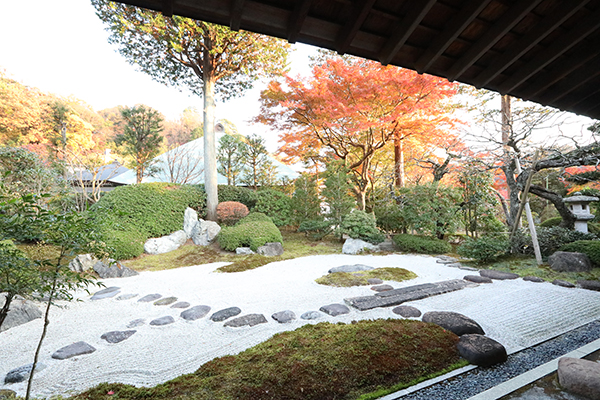
Jōmyōji Temple is the fifth of the Five Great Zen Temples of Kamakura. You can see the rock garden from the tea room. We recommend the Japanese-style veranda to take the best pictures.

You can see peonies, plum blossoms, and crepe myrtle in the temple grounds, as well as October cherry blossoms in the autumn. Each season has its own flowers to welcome you.
Jōmyōji Temple
Address:3-8-31 Jōmyōji, Kamakura City
Tel.:0467-22-2818
Admission:¥100
Hours:9:00–16:30 (Kisenan opens at 10:00, last order at 16:15)
Regular holiday:Open every day (Kisenan closes for the year-end and new-year’s holidays)

Hotel Metropolitan Kamakura
Front desk staff
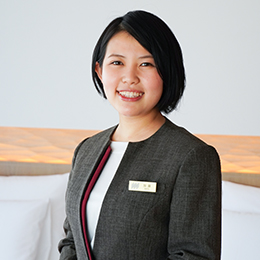
Hotel Metropolitan Kamakura
Front desk staff

Hotel Metropolitan Kamakura
Hotel Metropolitan Kamakura
Surrounded by mountains and the sea, Kamakura enjoys a warm climate all year round. Kamakura is one of Japan's leading tourist destinations, and is home to a large number of historical buildings, including shrines and temples, and many other attractions such as celebrated restaurants and leisure spots.
HOTEL METROPOLITAN KAMAKURA has been designed on the theme "Experience a New KAMAKURA", aimed at encouraging visitors to the area to stay the night and discover all the attractions the ancient city of Kamakura has to offer.
With warm, sincere and professional service befitting The METROPOLITAN HOTEL brand, a brand based on the concept of "Crossing comfort and vibrancy", HOTEL METROPOLITAN KAMAKURA welcomes all our guests with heartfelt hospitality to ensure their holiday is a memorable one.
NotesOpenClose
*Information provided on this website is current as of Febuary 2021. The featured facilities may change their fees, hours, days closed, menus, and other information after it has been published here, or they may be temporarily closed. Although every effort has been made to ensure the accuracy of the content on this website, including all times, fees, etc., we recommend that you contact the facility by phone or other means to get further information or make a reservation in advance. We will not be held liable for any damage in connection with the content of this website.
*All charges and fees shown on this website include consumption tax and were current at the time the information about them was collected. Facilities that offer dine-in and/or takeout services are so noted in the articles. Charges and fees are subject to change.
*Facility schedules do not reflect closures during the year-end/New Year holidays, Bon festival, and Golden Week as well as temporary closures unless specified by the respective facilities featured on this website.
*Operating hours shown on this website are generally the hours from opening to closing unless otherwise specifically noted. Last orders and entries are usually accepted 30 minutes to 1 hour before closing.
SHARE


